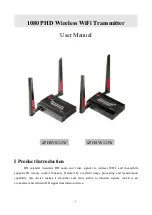
- 42 -
DANGER - For installation in Hazardous
Areas, i.e. areas with danger of fire and/or explosion,
irrespective of the protection mode used, the
installation must carried out in accordance with
local regulations. Ensure also that the temperature
of the transmitter does not exceed the value
indicated in the Safety Marking plate. In this
connection, consider that process temperature
above 85
°
C (185
°
F) requires derating the ambient
limits by 1.5:1 ratio.
Tank
Tank Nozzle
2" or 3" Tank nozzle
Extended diaphragm
Flush diaphragm
2" or 3" Tank nozzle
Figure 2 - Liquid level transmitter - Diaphragm options
Figure 1 - Liquid level transmitter - Installation
Flange-mounted transmitters are suitable for open or closed tank service.
The process fluid may, or may not, be corrosive, viscous, dirty and with suspended solids; each case requires a proper transmitter.
2600T Series provides a model for tank service.
They includes two main application variants: one is dedicated to liquid level measurement and the other is marketed as differential
pressure transmitter but it is particularly suitable for liquid level measurement.
Liquid level transmitter is mounted to a tank as shown in Figure 1.
The ambient temperature of the transmitter mounting location must be between -40
°
C and +85
°
C (-40 and +185
°
F).
The process temperature can instead be between -40
°
C and +320
°
C (-40 and +608
°
F). The process interface and fill fluid of the
transmitter must be selected amongst the various options provided according to the specific range of temperature.
ADDENDUM FOR FLANGE-MOUNTED TRANSMITTERS
The liquid level transmitter has been designed to connect to a flanged tank nozzle, or similar ANSI (DIN) fitting. Standard
connections for 2/3-inch Class 150/300/600 flanges, and equivalent DIN, are available.
Flush and extended diaphragm options are also available,
Figure 2.
The flush diaphragm is suitable for applications where the
process is free of suspended solids.
The extended diaphragm eliminates the pocket at the transmitter
connection and is typically used for slurries and viscous liquids.
It is recommended that the liquid level transmitter be mounted with the process diaphragm vertical and with the housing above
the primary transducer as described in the pictures.
Operation is not affected by mounting in other positions, however, some rezeroing may be required.
The transmitter is insensitive to level changes over the lower half of the diaphragm, so it is important to locate the transmitter datum
line with the center line of the tank nozzle. The nozzle also must be located so that the minimum level is always at or above the
datum line.
The liquid level transmitter can be used to measure liquid level in either open or closed (pressurized) tanks.
S
N
O
S
S
T
I
U
C
R
I
C
S
E
L
N
O
I
N
E
T
S
O
S
T
U
R
R
E
V
U
O
C
E L
R E
D
R
A
G
T N
E'
M
E
F
N
E
B
E
L
C
I
Q
U
A T
E
AL
S
T
I
U
C
RI
C
IVE
H
C O
P
E E
K
VER
TIG
T
E
H
W
N
!
S
N
O
S
S
T
I
U
C
R
I
C
S
E
L
N
O
I
N
E
T
S
O
S
T
U
R
R
E
V
U
O
C
E L
R E
D
R
A
G
T N
E'
M
E
F
N
E
B
E
L
C
I
Q
U
A T
E
AL
S
T
I
U
C
RI
C
IVE
H
C O
P
E E
K
VER
TIG
T
E
H
W
N
!
S
N
O
S
S
T
I
U
C
R
I
C
S
E
L
N
O
I
N
E
T
S
O
S
T
U
R
R
E
V
U
O
C
E L
R E
D
R
A
G
T N
E'
M
E
F
N
E
B
E
L
C
I
Q
U
A T
E
AL
S
T
I
U
C
RI
C
IVE
H
C O
P
E E
K
VER
TIG
T
E
H
W
N
!
Содержание 264B
Страница 53: ... 53 ...
Страница 54: ... 54 ...















































